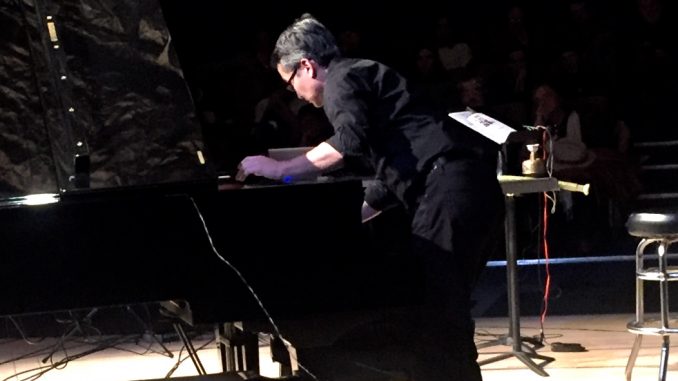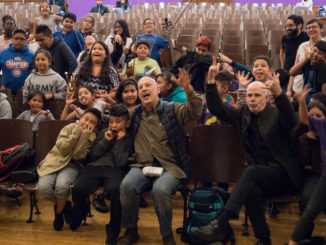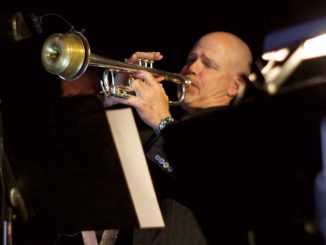
Marking its 20th Anniversary this year, the critically acclaimed Fulcrum Point New Music Project (FPNMP) combined with The 13th Annual Chicago Latino Music Festival in presenting an adventure in programming of new art music entitled ¡Revolución! The one-night only interactive concert experience featuring electroacoustic music from Mexican composers took place on October 28, 2018 at Constellation, 3111 N. Western Ave, Chicago.
¡Revolución! was supported by the MacArthur Foundation and the Mexican Centre for Music and the Sonic Arts (CMMAS). CMMAS formed in 2006 with the mission to promote the development of music and sound art in Mexico. This unique program formed an intersection of composition and technology. “We look forward to taking the audience on a sonic journey with Álvarez’s World Premiere and other works exploring the broad range of styles, compositions and improvisations from the Mexican avant-garde”, said Fulcrum Point Artistic Director Stephen Burns. The program was introduced by Chicago Music Festival Director Elbio Barilari; co-director Gustavo Leone was also in attendance.

¡Revolución! asked the questions:
What happens when technology takes control?
What happens when free notation and random variation is computer controlled?
What happens when the audience has agency to influence the sounds in real time?!
The Virtuoso Performers:
Stephen Burns- trumpet
Jeremy Ruthrauff- saxophone
Ian Ding- percussion
Chuck Webb- electric bass
Kuang Hao Huang- piano
The Supersonic Program:
–Jorge Sosa – Time Wave Zero, 2012
Many people are aware of the myths surrounding the end of the Mayan Calendar on December 21, 2012; Timewave Zero is a theory heavily entrenched in this ‘end of world’ mythology. This idea was crafted sonically and acoustically into a composition by New York City electroacoustic composer Jorge Sosa; embodied in the live performance was the outstanding talent of all 5 FPNMP performance performers playing and improvising over a lush manipulated soundscape. There’s “an element of chance” built into the piece, and an ambient quality to the music. In addition to the fixed music, there are a variety of filters or effects that influenced the choices that were made by the musicians; in particular, Steve Burns’ trumpet sounded sweet, intricately phrased, pure.

–Gabriela Ortiz – El Trompo, 1994
The double Latin Grammy nominated Ortiz is one of the foremost composers in Mexico today. This score, for vibraphone and tape, presented by Ian Ding, contains a musical depiction of a child playing in the street with a spinning top wound about with string. As described by the composer, the boy throws the toy into the air with great force and when it lands on the palm of his open hand, the “trompo” begins to dance around it’s own center of gravity. Ortiz further describes the toy’s spinning causes the conception of time to disappear.
Superimposed on a simple, gay melody that is not based upon any particular musical genre; the tape, according to Ortiz, is to function as “a conditioned reflex generated by the vibraphone solo”. The taped components consist of percussive metallic sounds transformed and electronically manipulated. As Ding performed with four soft mallets, he swayed to a rhythm and seemed to perceive the tape as intended, “a musical kaleidoscope”; meanwhile the solo portions explored a myriad of melodic capacities of the vibraphone.

– Luis Fernando Amaya – Pregunta #2: Cóndor, 2017
“I am interested in how one “thing” (an object, a word, a concept, even a person) can be interpreted by means of two or more contrasting collective memories; this piece was written with my mind sitting in the middle of the clash between two contrasting collective memories aroused by the word ‘cóndor.’” Luis Fernando Amaya, from Pregunta no.2: Cóndor program notes.
For the 2 collective memories, Stephen Burns advised the audience to conceptualize the flight of an Andean condor, a vulture and the largest flying bird in the world, and Operation Condor, “a US backed campaign of political repression and state terror involving intelligence operations and assassination of opponents, officially implemented in 1975 by the right-wing dictatorships of the Southern Cone of South America”.
The piano music, performed by Kuang Hao Huang using, among other devices, 2 E-Bows, was eerie, spatial, wildly intriguing and unlike any piano music this reviewer had ever heard, as the pianist “played” mostly inside the piano box, less so on the keys.
The work explored the possibilities and permutations of timbre and harmonics, producing it’s own universe of segmented, segregated sounds. Slow, widely spaced string resonances project the condor as a military presence; at times there are periods of silence. As one listens, the very envelope of time is distorted while Huang effectuates the nuances of the score. While this accomplished pianist seemed very deliberate in his actions, it also seemed that even he was not fully in control of the unusual shape of what developed as the E-bows touched various strings and changed the landscape and resonance of the piece. This was an eerie, unsettling piece, a venture into the unknown.

– Arturo Fuentes – Plexus, 2009
To describe this extraordinary work, performed with blinding skill by Jeremy Ruthrauff on saxophone, let me quote two remarks culled from the composer’s website: “Arturo Fuentes proposes that you listen to his music like ‘a fusion of colours within a dome full of grain’” and he also writes: “I select a sonorous line and walk with it. The breaks in the line, changes in speed, suspended moments, etc. – all of these things lead to the emergence of a sonorous form and musical context.“ The presentation was a tour de force.

– Javier Álvarez – Grain Junctions, 2018
Presented in collaboration with the Morelia, Michoacan-based Mexican Center for Music and the Sonic Arts this groundbreaking electroacoustic work from renowned Yucatan-based composer Javier Álvarez was created as part of the MacArthur Foundation International Connections Grant. Both fluid and flexible, the instrumental solos in the piece were augmented by electronic music created in collaboration with the students from Latina Girls Code and The People’s Music School at Lara Elementary School.
Utilizing BAFTA-nominated composer/synthesist Joel Corelitz’s smartphone app, “Shortwave”, a collaborative musical platform designed for live events, the audience had the chance to interact with the new work and the musicians on stage by manipulating the electronic sounds on their smartphones, producing a collaborative concert experience.
Performed by the entire ensemble, the piece was strong, evocative, rhythmic, sonic yet melodic. It was crafted as a thorough collaboration, and celebrated composer Javier Álvarez ultimately switched his intended technique technique, using “pointillistic” or “grainy” textures. The instruments highlight a funky, “derailed” jazzy profile. In addition, there were 4 sections when the audience joined in- I myself pushed the instrument panel with what I hoped was a clever beat!. The theory was that all sounds would be integrated, and it certainly sounded that way; there was no element of anarchistic chaos in the resulting production. Throughout, Chuck Webb on electric bass wove a gorgeous phalanx of insistent spectral effects.
In fact, the piece was distinctly beautiful, with layer upon layer of irresistible symphonic impressions that surfaced in waves, each meeting and succeeding the other.

From the simple to the sublime, tech was at the core of this 75-minute set of electroacoustic Mexican music.
For information and tickets to all the programming of Fulcrum Point New Music Project, go to www.fulcrumpoint.org
For information and tickets to the remaining concerts of the Chicago Latino MusicFestival, go to www.latinomusicfest.org




Be the first to comment